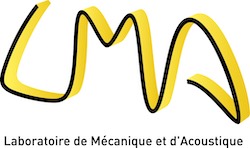Dates : Start date between 01/02/2023 and 01/04/2023 – Duration 5 months
Location : Laboratory of Mechanics and Acoustics (LMA) – Sounds Group, Marseille, France.
Possibility of short research stay at CSIC (Madrid).
Payment : academic rate funded by The Institute of Mechanical Engineering of Aix-Marseille University (Project “Metamaterials”).
Problematic : One of the challenges encountered in the field of aeronautical and surface
transports is to design compact lightweight liners or silencers able to significantly reduce the
transmission and back-reflection of low-frequency noise sources (combustion noise, fan
noise...) that propagate in a low-speed ducted flow. The interest of reducing back-reflections
of acoustic waves towards the combustion chamber is to keep a high combustion efficiency of
thermal engines (fuel, hydrogen). Silencers also have to maintain a constant flow rate and
minimum pressure drop.
 State-of-the-art silencers are expansion chambers filled with porous materials shielded
from the flow by perforated cylinders [Fig. 1, left]. These quarter-wavelength resonators are
only efficient above 1 kHz to reduce noise transmission over a limited bandwidth, and with
significant back-reflections. They would require unrealistic large cross-sectional volumes
(resp. axial lengths) to achieve low-frequency (resp. broadband) noise attenuation. Innovative
“engineered silencers” [Fig. 1, middle] based on the Acoustic Black Hole (ABH) effect are a
promising alternative. They should be able to slow down and trap sound waves within their
internal shaped cavities, and to fully absorb the incident energy through visco-thermal
dissipation. Broadband absorption is achieved due to merging of the individual cavities
resonances. As a result, only the incident wave field propagates without back-reflections, nor
transmission [as simulated in Fig. 1, right]. Strategies such as micro-perforations can be
implemented to downshift the bandwidth of absorption towards low-frequencies while
keeping a compact device.
State-of-the-art silencers are expansion chambers filled with porous materials shielded
from the flow by perforated cylinders [Fig. 1, left]. These quarter-wavelength resonators are
only efficient above 1 kHz to reduce noise transmission over a limited bandwidth, and with
significant back-reflections. They would require unrealistic large cross-sectional volumes
(resp. axial lengths) to achieve low-frequency (resp. broadband) noise attenuation. Innovative
“engineered silencers” [Fig. 1, middle] based on the Acoustic Black Hole (ABH) effect are a
promising alternative. They should be able to slow down and trap sound waves within their
internal shaped cavities, and to fully absorb the incident energy through visco-thermal
dissipation. Broadband absorption is achieved due to merging of the individual cavities
resonances. As a result, only the incident wave field propagates without back-reflections, nor
transmission [as simulated in Fig. 1, right]. Strategies such as micro-perforations can be
implemented to downshift the bandwidth of absorption towards low-frequencies while
keeping a compact device.
However, these types of ABH mufflers obstruct the flow and cannot be used as such in a
flow duct. The question of designing fully- or adequately-open ventilated silencers based on
the ABH principle with high aero-acoustic performance is not yet solved and is the subject of
this Master internship.
The candidate profile should be mainly in Acoustics, with knowledge/practice of the finite element method, and interests in modeling and using acoustical experimental techniques.
![]() If sufficient results are obtained that go beyond the state-of-the-art, the student will
be included as a co-author in an international conference paper.
If sufficient results are obtained that go beyond the state-of-the-art, the student will
be included as a co-author in an international conference paper.
![]() A PhD 3-years doctoral grant has been requested for a follow-up to this study.
A PhD 3-years doctoral grant has been requested for a follow-up to this study.
More informations about Objective, Methodology or References here :



